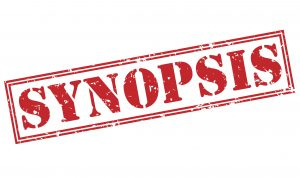Writing a good synopsis is very important. Like a blueprint or microcosm, its purpose is to help agents/publishers understand everything they need to know about who you are and what your book is about in a nutshell. (The synopsis is not meant to be for the general public.)
Some agents/publishers ask for a synopsis and nothing more.
Think of the it as a sales pitch for the book, like a slick ad or trailer for a film, or a sizzle reel for a gorgeous actor. Good packaging may stir interest, but it's not nearly enough.
Prospective agents/publishers want to know who you are, what you can do, and how you fit into existing markets (genre and sub-category) or could possibly create new ones, as Anne Rice managed to do.
The best synopses are very simple, crystal clear, and compelling.
Demonstrate that you have mastered the book's narrative by giving the synopsis a strong narrative. Be aware of tone and pacing. And be aware of who your audience is and the book's relatable themes, the author's point of view in the story, turning points, epiphanies, etc.
Be sure to deliver what the book promises, and give a sharp vision of the book. The shorter the synopsis is, the better.
Most synopses are 2-3 pages long. Congratulations if you can get it down to 1 page, and don't worry if it's a bit longer for a very long book.Here are the points you'll want to include
Context -- introduce us to the world of this book
Over-arching conflict/goal -- what's the challenge?
Narrator's point of view -- whose story? what do they need? Who is the book for?
What happens -- the most fascinating highlights/crises (3-4 plot points)
What happens -- transcendence/transformation/epiphanies
Resolution -- a great conclusion that gives an idea of the ending
Common errors
Don’t let it be a boring laundry list of sequential events
Don’t focus on (striking) specifics that may not be important to the whole book
No unified writer’s voice
SAMPLE NON-FICTION SYNOPSIS – SELF HELP
THE NEXT HAPPY: LET GO OF THE LIFE YOU PLANNED
AND FIND A NEW WAY FORWARD
by Tracey Cleantis
NOTE – Tracey chose to write her non-fiction book proposal in first person. You can see that she has a very sassy and
unique writing style and she felt that this was the best way to summarize her book. It's almost 2 pages long.
[Context – the world of the story]
We live in an age that is defined by the myth of Sisyphus—the Greek guy who was forced to roll a rock up a hill for all eternity, never to get to where he was going, never-ever to be done. It’s the myth that makes the somewhat counter-intuitive point that it’s not so much if you win or lose as long as you keep trying—relentlessly. The mottos for our time might well be defined by the never-say-die poster-boy Lance Armstrong and his famous dictum that “Pain lasts for a moment but quitting lasts forever,” or by Winston Churchill’s hallowed advice to “Never, never, never give up.” Churchill was not, for the record, an American, and according to historians, might have been better off retreating on an occasion or two. That said, his English bulldog advice seems to belong more to baseball, apple-pie and Chevrolet than it does to cricket- playing blokes who drink warm beer and drive their lorries on the wrong side of the rode. It is, after all, the American Dream, not the British Dream or the Chilean Dream. This country was built on the foundation of a can-do spirit, a belief that if you just want it badly enough and work hard enough, anything is possible—including becoming an astronaut, landing a talk show gig, having a child, keeping a broken marriage together, or getting rich enough from your killer app to retire to Aruba. This relentless belief in what is possible is all well and good when you’re gearing up for greatness, and at that stage of the process you will find endless workshops, conferences and books to help you harness the power of intention, understand “the Secret,” live your best life, awaken the Giant, unleash your power, find your cheese, and achieve your dream.
[What is standing in your reader’s way?]
But guess what? No matter how many Secrets you have or how much cheese or power you possess, nothing is guaranteed. It simply isn’t true that if you work hard enough you will get what you desire. It just isn’t. I hate to break the “Yes you can!” bubble, but the myth is a big-fat lie and the truth is that there are limits to what we can achieve. This is the dark side of the dream that no one likes to talk about—and that few people outside of the therapeutic setting are working to alleviate—and that lack of attention is only deepening the pain. Consider these sad and sobering statistics:
• 41% of first, 60% of second and 73% of third marriages end in divorce.
• 1.5 million women are infertile, and 1 out of every 5 couples are involuntarily childless.
• 50% of American college graduates are underemployed and 80% of people are dissatisfied with their jobs.
• 50% of businesses fail in their first year; 56% percent fail in the next five-years
• In one recent year 2,698,967 homeowners lost their dream home to foreclosure
• 85% of actors are unemployed.
• Of all college level basketball players, less than .00007 percent successfully make it to the NBA.
[What does your reader desperately need/want?]
Within those numbers lies the heartbreak of millions of people who relentlessly hammer away at their dreams regardless of the high costs associated with dreaming. Within those numbers is the explanation for why, as The New York Times recently reported, there has been a surge in suicide among middle aged men. Within those numbers is the story of the pervasive sense of failure that pervades the first generation of Americans that just might not be able to build a better life than
their parents. We all know people who won’t get divorced even though their marriage has become a soulless sham; they won’t stop tinkering in the garage on their brilliant idea even though they’re the only one of their peers without health insurance or enough money in the bank to fix the car should it break down; they won’t stop believing that any day now—any day now! – their boss is going to waltz in, hand them a fat bonus, and escort them to the corner office, which will make the fact that they ruined everything in their life (including their marriage, their health and their relationship with their children) somehow all worth it, in the end. Only the day never arrives and the redemption doesn’t happen.
[Who is your book for? What happens?]
The Next Happy is written for all of these people. It will dare to challenge the notion that the time to let go of a dream is never. It will be a book that offers a much needed counterpoint to the endless “yes you can” sentiment that pervades our culture. It will offer a psychological explanation of the process of letting go, insight into the grief, and a road-map to the other side of the impossible dream, where unexpected happiness waits.
[Resolution]
The result should be a huge wave of relief and a shift away from the insidious “never say die” philosophy that is part of our national zeitgeist. Readers will come away from this book with real and tangible tools that will allow them to move through the stages of grief and begin to conceptualize the death of their dream in a different way. They will discover strengths, resources, and a new, healthy way forward.
And I will be the Dr. Kevorkian of dreams.
Fiction & Non-Fiction SAMPLES can be found in pdf form at: http://static1.squarespace.com/static/5074dd9de4b01e64d213089e/t/5669c485dc5cb41762f6e3c0/1449772165861/Synopsis+Samples.pdf .
They are from authoraccelerator.com and jennienash.comGenres Most In Demand Thus Far, 2024
·
Which genres are most in demand this year by agents and publishers? Drum roll, please…






